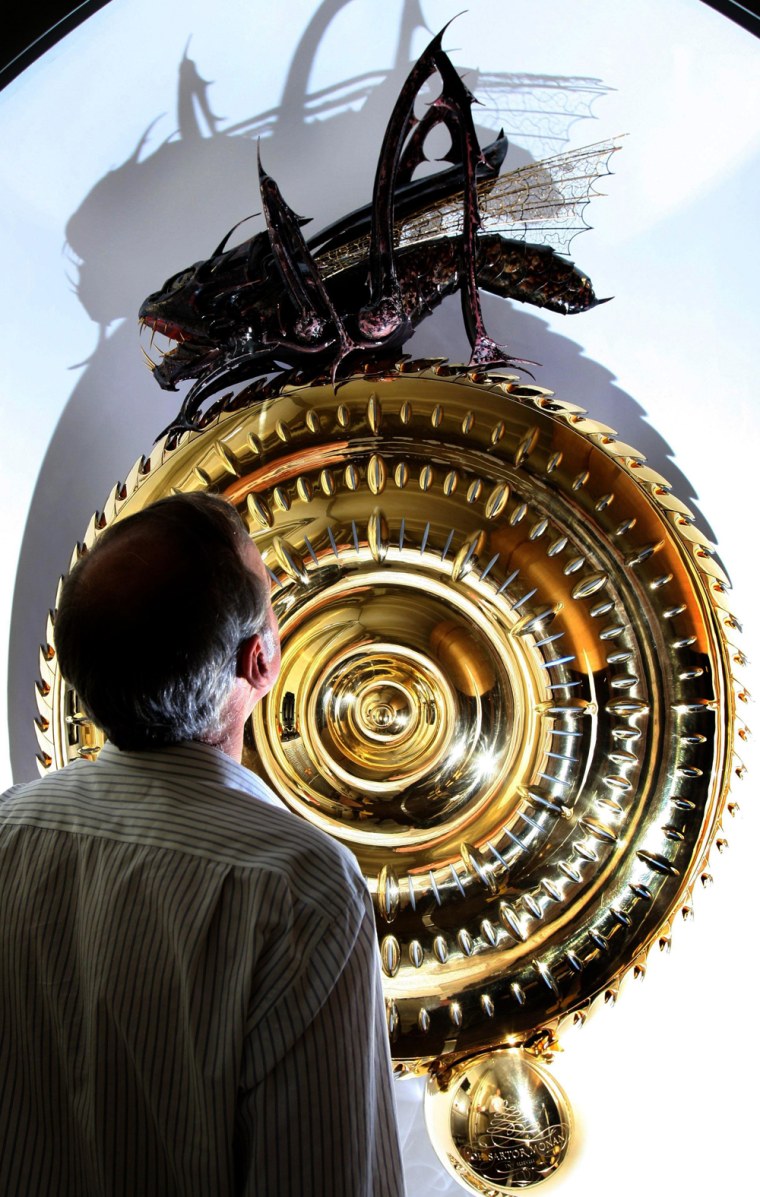Most clocks just tell time, simply and reliably. Not the $1.8 million "time eater" formally unveiled Friday at Corpus Christi College in Cambridge.
The masterpiece, introduced by famed cosmologist Stephen Hawking, challenges all preconceptions about telling time. It has no hands or digital numbers and it is specially designed to run in erratic fashion, slowing down and speeding up from time to time.
Inventor John Taylor used his own money to build the clock as a tribute to John Harrison, the Englishman who in 1725 invented the grasshopper escapement, a mechanical device that helps regulate a clock's movement.
Making a visual pun on the grasshopper image, Taylor created a demonic version of the insect to top of the gold-plated clock face where it devours time.
The beast — with its long needle teeth and barbed tail — rocks back and forth, ultimately inserting its talons in notches at the top of the clock to move it forward. Halfway through the minute the grasshopper's jaws begin to open, snapping shut at 59 seconds.
"Time is gone, he's eaten it," said Taylor, who calls the oversize grasshopper "Chronophage," which translates to "time eater."
"My object was simply to turn a clock inside out so that the grasshopper became a reality," Taylor said.
At the unveiling, Hawking predicted the creature atop the clock would become "a much-loved, and possibly feared, addition to Cambridge's cityscape."
Taylor said he also hopes the clock will remind people of their own mortality.
Rather than having it toll the hour by a bell or a cuckoo, the clock relies on the clanking of a chain that falls into a coffin, which then loudly bangs closed.
"I'm in my early 70s and I realize that time is a destroyer," Taylor said in a telephone interview. "When you're a young person you think there is plenty of time.
"The sound was to remind me of my mortality."
The clock, four feet in diameter, displays time using light-emitting diodes. The light races around the outer ring once every second, pausing briefly at the actual second; the next ring inside indicates the minute, and the inner ring shows the hour.
The lights are constantly on, the apparent motion regulated mechanically through slots in moving discs.
Weirdly, the clock's pendulum slows down or speeds up. Sometimes it stops, the chronophage shakes a foot and the pendulum moves again.
Because of that, the time display may be as much as a minute off, although it swings back to the correct time every five minutes, said Taylor.
"There are so many expressions in everyday life about time going fast, time going slow and time standing still. Your life is not regular, it's relative to what's going on," Taylor said.
He cites Albert Einstein's observation: "When a man sits with a pretty girl for an hour, it seems like a minute. But let him sit on a hot stove for a minute and it's longer than any hour. That's relativity."
The clock is the showpiece of Corpus Christi's new library, also a gift from Taylor. His wealth comes from inventing controls for electric tea kettles, inventions which he estimates are used 1 billion times a day around the globe.
"I'm an inventor so I try to do things different to the way they've done before," Taylor said.
"Clocks are boring. They just tell the time, and people treat them as boring objects," he added. "This clock actually interacts with you, because you don't expect a clock to do anything."
